Chromosomes are best defined as ______.
the structures within living cells that contain the genetic material
Which of the following are the major components of a chromosome?
Proteins
DNA
What is chromatin?
A complex between DNA and proteins that is found in eukaryotic cells
Which term best describes organisms whose chromosomes are not contained within a membrane-bound nucleus?
prokaryotes
The ____ of a prokaryotic cell is the region of cytoplasm that contains the chromosome.
Nucloeid
The structures within all living cells that contain the genetic material are called
chromosomes
A chromosome contains a very long segment of ____, which is bound to ____ that provide structure.
DNA
proteins, polypeptides, or histones
This diagram depicts a bacterial cell. Match the letter to the correct structure.
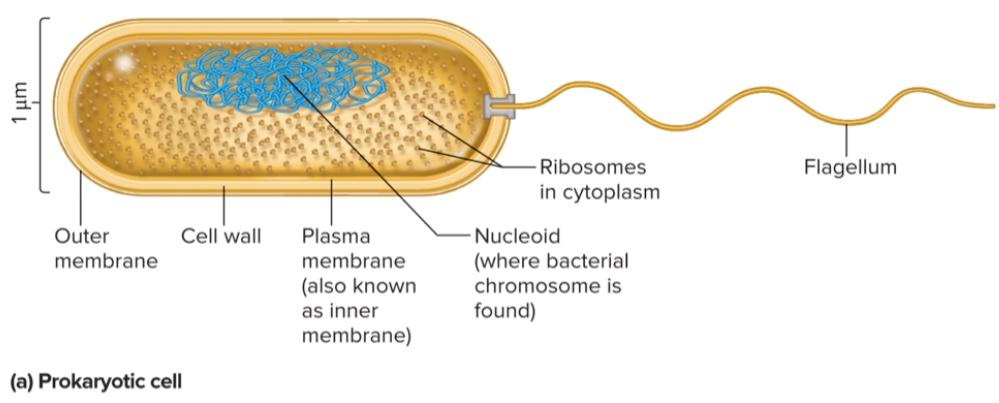
- A
Outer membrane - B
Cell wall - C
Cell membrane - D
Nucleoid - E
Ribosome - F
Flagellum
What is the name for the diffuse complex of DNA and proteins in a eukaryotic cell?
chromatin
Which of the following are eukaryotes?
Multiple select question.
Protists
Fungi
Archaea
Plants
Bacteria
Protists
Fungi
Plants
Prokaryotes, which include the ____ and the ____ , are organisms that lack a membrane-bound nucleus.
bacteria
archaea
Prokaryotes usually have a single type of circular chromosome in a region of the cytoplasm called the ______.
nucleoid
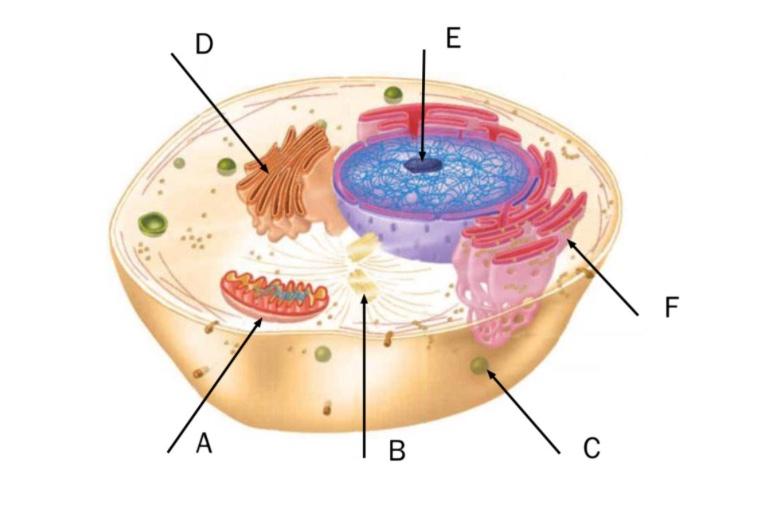
This diagram depicts a eukaryotic cell. Match the letter to the correct structure.
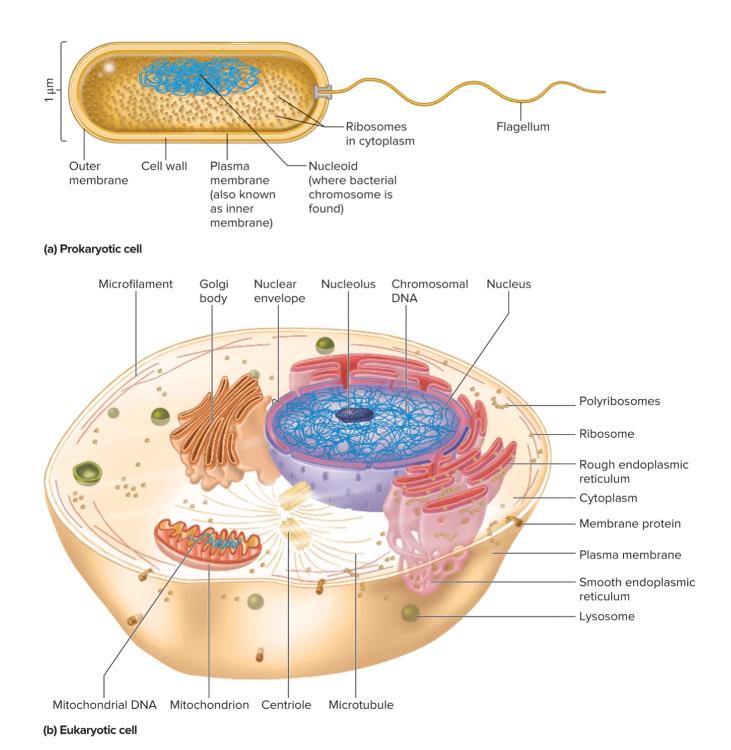
- A
Mitochondrion - B
Centriole - C
Lysosome - D
Golgi body - E
Nucleolus - F
Endoplasmic reticulum
In eukaryotes, ____ are membrane-bound structures that have specific functions.
organelles
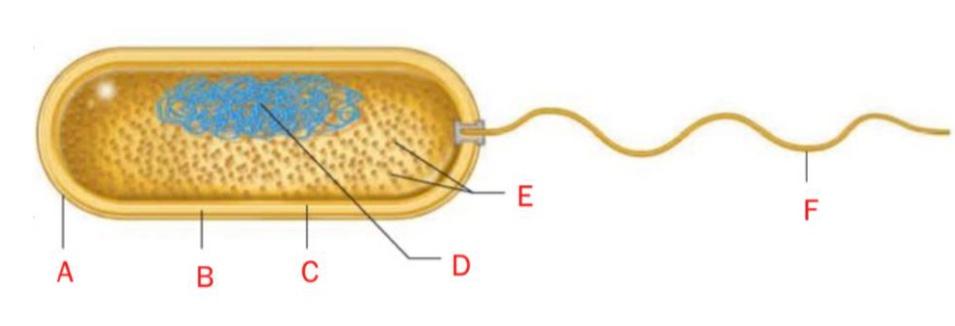
Select all that apply
In this figure of a bacterial cell, which of the following labels are correctly matched with their appropriate structures?
C = Plasma (inner) membrane
F = Cilium
E = Ribosome
B = Outer membrane
A = Cell wall
D = Nucleus
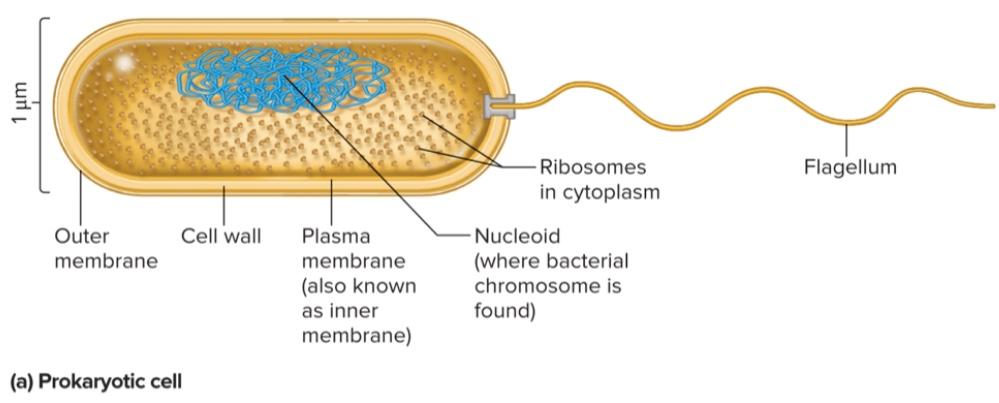
C = Plasma (inner) membrane
E = Ribosome
Which of the following best describes the nucleus?
An organelle of prokaryotes that is surrounded by a single membrane.
An organelle of eukaryotes that is surrounded by a single membrane.
An organelle of prokaryotes that is surrounded by two membranes.
An organelle of eukaryotes that is surrounded by two membranes.
An organelle of eukaryotes that is surrounded by two membranes.
Organisms, such as protists and fungi, that have a true nucleus are called ____.
eukaryotes
Select all that apply
Which of the following organelles contain their own DNA?
Multiple select question.
Mitochondria
Lysosomes
Golgi bodies
Chloroplasts
Mitochondria
Chloroplasts
What is cytogenetics?
The field of genetics that involves the microscopic examination of chromosomes.
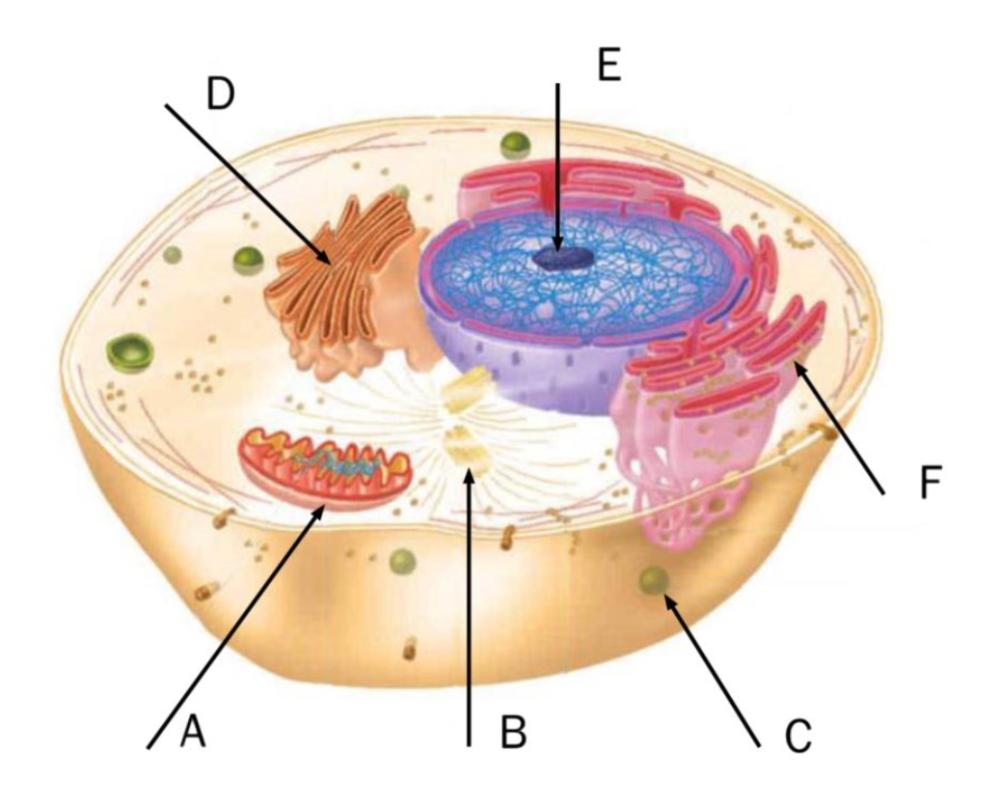
Select all that apply
In this figure of a eukaryotic cell, which of the following labels are correctly matched with their appropriate structures?
Multiple select question.
C = Lysosome
B = Centriole
F = Golgi body
A = Mitochondrion
E = Ribosome
D = Endoplasmic reticulum
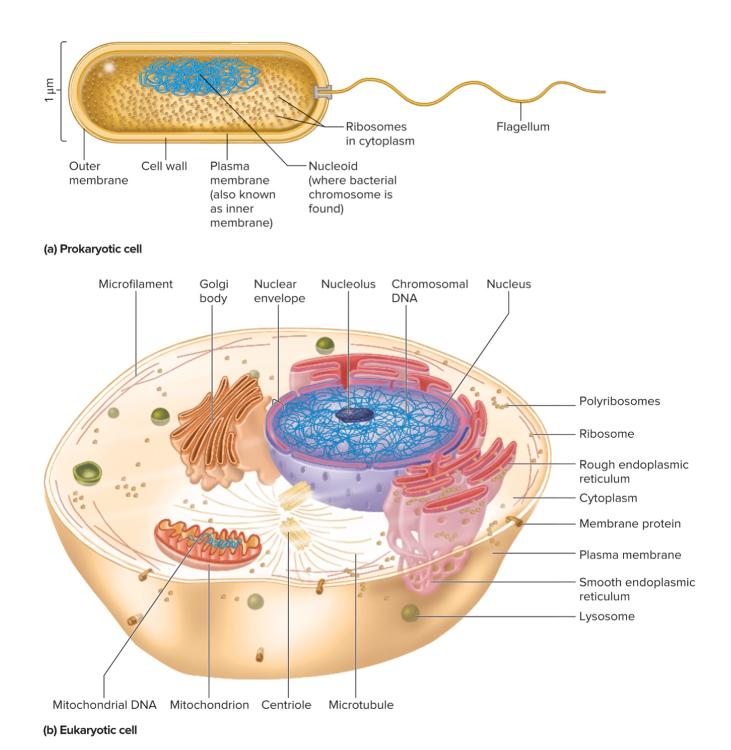
C = Lysosome
B = Centriole
A = Mitochondrion
True or false: Each species has a particular chromosome composition.
True
An organelle is ______.
Multiple choice question.
a structure within the cytoplasm with a specific function
the DNA-containing structure of an organ system
a complex found in the cell membrane of a cell and which facilitates nutrient transport
a structure within the cytoplasm with a specific function
The procedure for making a karyotype includes all of the following steps except ______.
Multiple choice question.
sequencing the DNA
centrifugation to concentrate the cells in a pellet
treatment with chemicals that bind to the chromosomes and stain them
treatment with chemicals that stimulate cell division
treatment of the cells with a hypotonic solution
sequencing the DNA
The ____ of a eukaryote is the organelle that contains most of the genetic material found in the cell.
Nucleus
In addition to the nucleus, eukaryotic organelles called the ____ and the ____ contain a small amount of their own DNA.
mitochondrion or mitochondria
chloroplasts or chloroplast
The field of genetics that involves the microscopic examination of chromosomes is called ____.
cytogenetics
Which is the best definition of a karyotype?
An organized representation of the chromosomes within a cell
In general, the chromosome number of a particular species ______.
is the same for all individuals of the species
The following are steps used in the procedure for making a karyotype. Arrange them in order, starting with the first step at the top.

Answer in the picture
Which of the following statements about eukaryotes is true?
Multiple choice question.
Most eukaryotic species are diploid or have a diploid phase to their life cycle.
All eukaryotic species are diploid or have a diploid phase to their life cycle.
Few eukaryotic species are diploid or have a diploid phase to their life cycle.
Most eukaryotic species are diploid or have a diploid phase to their life cycle.
An organized representation of the chromosomes within a cell is called a(n)
karyotype
A diploid cell is defined as a cell that has ______.
two sets of chromosomes
two pairs of chromosomes
two chromatids for each chromosome
two nuclear membranes
two sets of chromosomes
True or false: Each species has a particular chromosome composition.
True
Insert a number into the blank: Most human somatic cells contain a total of ____ chromosomes.
46
The procedure for making a karyotype includes all of the following steps except ______.
Multiple choice question.
treatment of the cells with a hypotonic solution
sequencing the DNA
treatment with chemicals that bind to the chromosomes and stain them
treatment with chemicals that stimulate cell division
centrifugation to concentrate the cells in a pellet
nucleus
In a diploid cell, each member of a pair of chromosomes is called a(n) ______.
homolog
True or false: Most eukaryotic species are haploid or have such a phase as a significant part of their life cycle.
False
In a ______ cell, each type of chromosome is a member of a pair.
diploid
The two members of a homologous pair of chromosomes may carry different versions of a given gene, which are called ____.
allele
A normal human somatic cell carries ______ pairs of chromosomes for a total of ______.
23; 46

The position of a gene on a chromosome, such as gene A in the image, is called its ______.
homolog
allele
locus
centromere
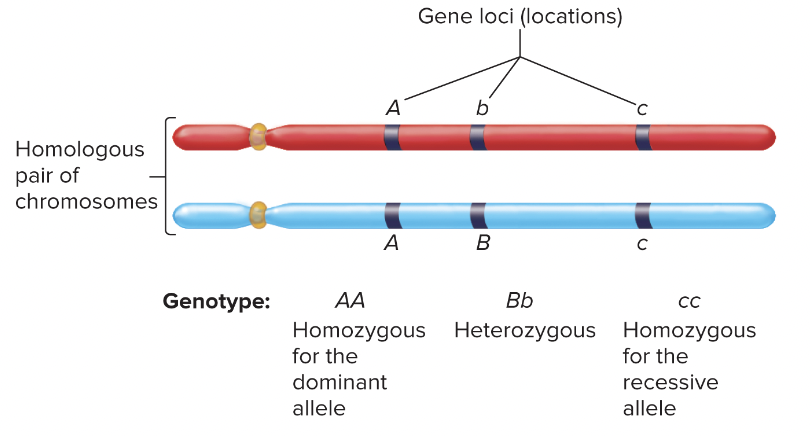
locus
Unicellular prokaryotic organisms proliferate by ____ reproduction, in which a preexisting cell divides to produce two new cells.
asexual
Each type of chromosome in a diploid cell is found in a homologous pair. Each chromosome in such a pair is referred to as a(n) ____.
homolog
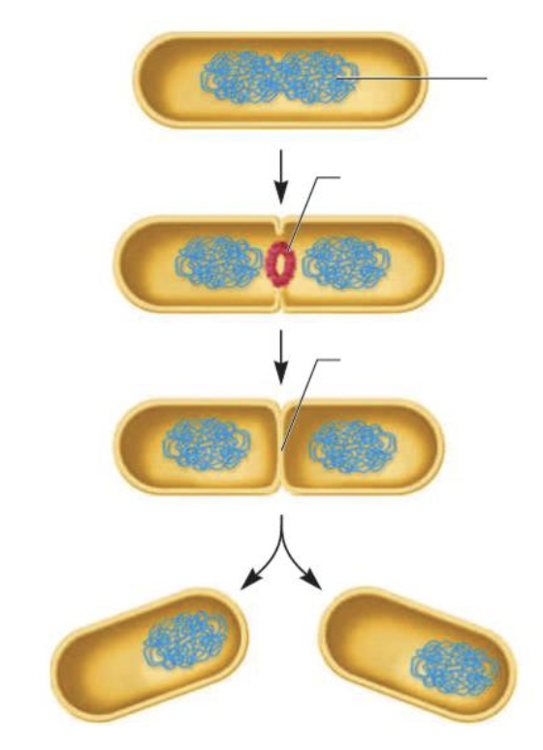
This figure shows a bacterium reproducing asexually by a process known as ____ .
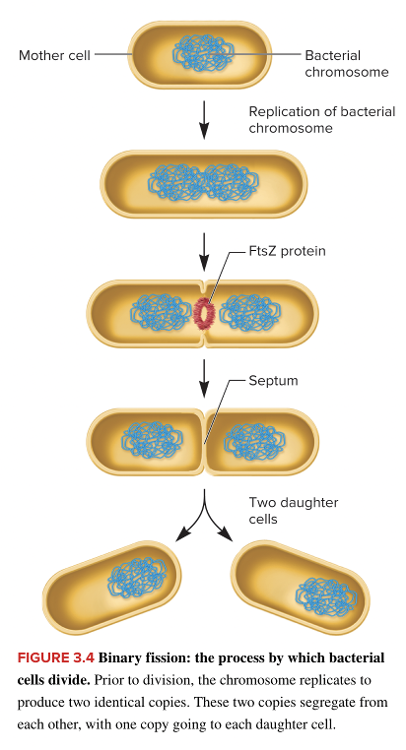
binary fission
Eukaryotic cells that are destined to divide progress through G1, S, G2, and M phases, which are collectively known as the ____ ____ .
cell cycle
______ are different versions of the same gene.
Loci
Homologs
Haplotypes
Alleles
alleles
Select all that apply
Which of the following are part of interphase?
Multiple select question.
Cytokinesis
M
G1
G2
S
G1
G2
S
A(n) refers to the physical location of a gene.
locus or loci
Which of the following best describes asexual reproduction?
Multiple choice question.
A mother cell divides to produce four unique daughter cells
A mother cell divides to produce two identical daughter cells
Two haploid gametes fuse to form a diploid cell
A mother cell divides to produce two identical daughter cells
A cell, such as most nerve cells in an adult mammal that will never divide again, is in the ______ phase.
G1
S
G0
G2
G0
Most bacterial cells divide by ______.
mitosis
binary fission
budding
fragmentation
binary fission
The eukaryotic cell cycle is composed of ______ phases called ______.
four; G0, G1, G2, and S
three; G1, G2, and S
three; G1, G2, and M
four; G1, G2, S, and M
four; G1, G2, S, and M
In actively dividing cells, the G1, S, and G2 phases are collectively known as ____.
interphase
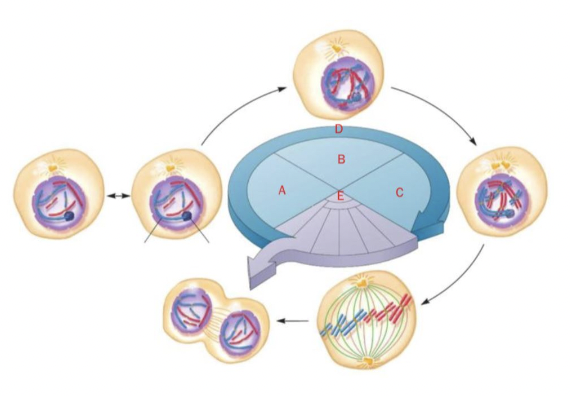
The following is a diagram of the eukaryotic cell cycle. Match the letter to the appropriate phase.
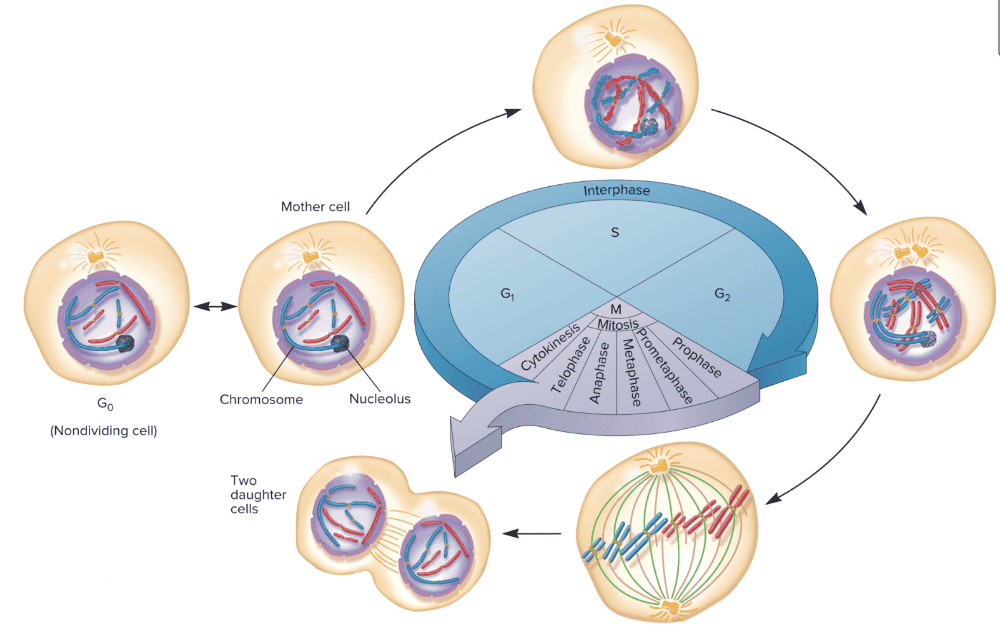
- A G1 phase
- B S phase
- C G2 phase
- D Interphase
- E M phase
Late in the G1 phase, many cell types become committed to progress through the rest of the cell cycle. When this occurs, the cell has reached a(n) ____ ____ .
restriction point
Which of the following phases of the cell cycle is considered a "resting" stage, where cells can remain permanently, or for long periods of time?
G2
M
G0
S
G1
G0
The two copies of a replicated chromosome are called ______.
Multiple choice question.
centrosomes
alleles
homologous chromosomes
sister chromatids
sister chromatids
A pair of sister chromatids is also called a ______.
Multiple choice question.
monad
tetrad
dyad
diplomonad
dyad
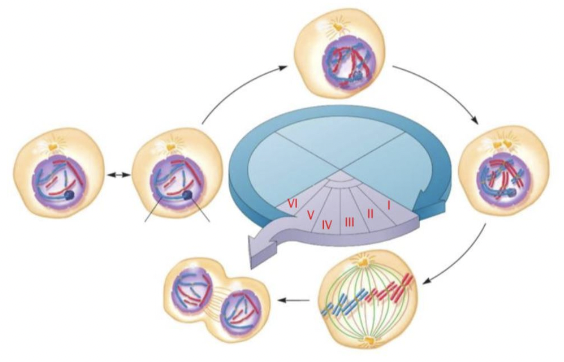
This figure depicts the cell cycle in eukaryotes, including the M phase. Match the letter to the appropriate phase.
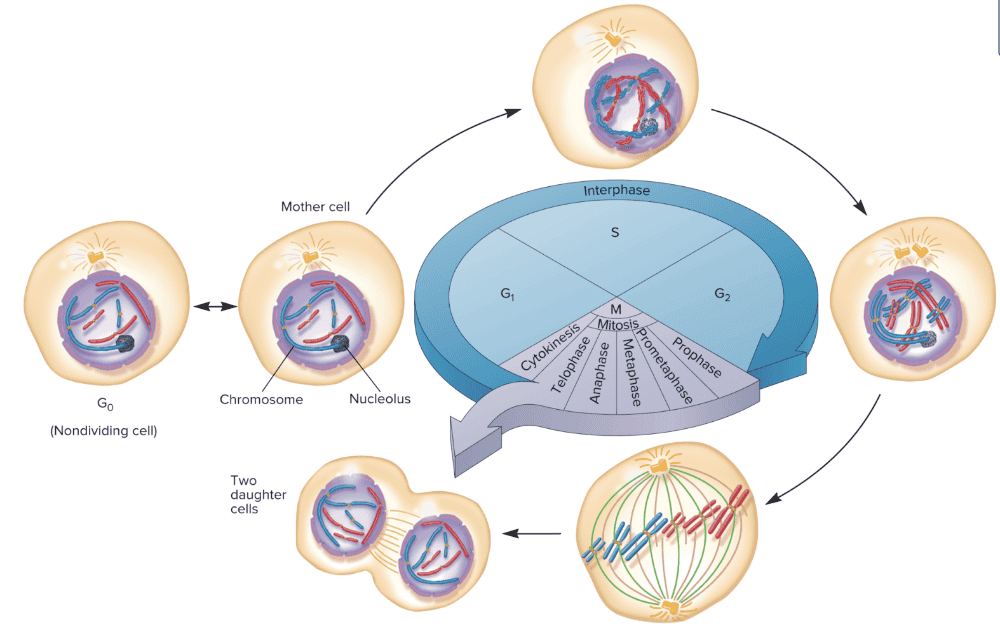
- I Prophase
- II Prometaphase
- III Metaphase
- IV Anaphase
- V Telophase
- VI Cytokinesis
The two chromatids of a chromosome are joined together at a region of DNA called the ____.
centromere
In mitosis, the restriction point is ______.
Multiple choice question.
the time in the G1 phase at which the cell becomes “committed” to the cell cycle
the time in the G2 phase at which the cell becomes “committed” to condense its chromosomes
the site where the cleavage furrow forms to divide the cell into two daughter cells
the site where the two sister chromatids of a replicated chromosome attach to each other
the time in the G1 phase at which the cell becomes “committed” to the cell cycle
The ____ is a protein-complex that is bound to the centromere, and which plays a key role in the separation of chromosomes during cell division.
kinetochore
After replication, each chromosome consists of two copies called ____.
chromatids, monads, chromatid, monad, sister chromatids, or sister chromatid
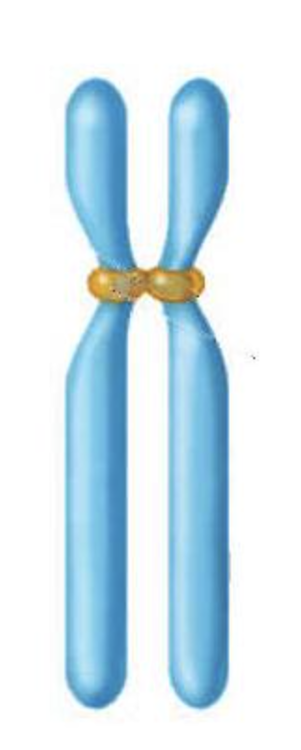
This diagram shows a pair of ____ ____.
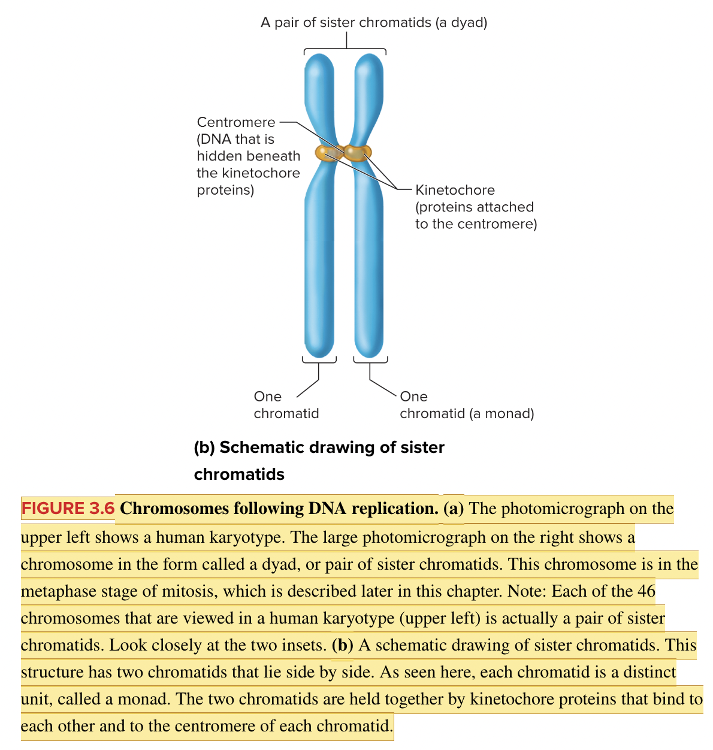
sister chromatids
A monad can be described as ______.
Multiple choice question.
one pole of a dividing cell
one strand of a double-stranded DNA molecule
a set of chromosomes
an unreplicated chromosome
an unreplicated chromosome
Insert a number into the blank: A human cell in the G2 phase has a total of ____ chromatids.
92
Fill in the blank question.
The meaning of the term chromosome can differ depending on the stage of the cell cycle we are observing. During ____ phase of interphase and early stages of M phase, a chromosome refers to a pair of sister chromatids (a dyad). However, at the end of M phase and during ____ phase of interphase, a chromosome refers to a monad which contains the equivalent of one chromatid.
G2; G1
The centromere is a ______.
region of DNA that serves as an origin of replication
complex of proteins that forms at the site of cell division
region of the chromosome where the sister chromatids join
complex of proteins that helps in replicating DNA
region of the chromosome where the sister chromatids join
After a mitotic division is complete, a daughter cell has 40 chromosomes. Which of the following best describes the chromosome composition of the mother cell in the G2 phase?
Multiple choice question.
40 chromosomes, each consisting of two chromatids
40 chromosomes, each consisting of one chromatid
80 chromosomes, each consisting of one chromatid
80 chromosomes, each consisting of two chromatids
40 chromosomes, each consisting of two chromatids
The kinetochore serves which of the following functions?
Multiple choice question.
It aids in chromosome sorting during mitosis.
It helps in the replication of DNA.
It regulates the length of the cell cycle.
It forms the cleavage furrow during cytokinesis.
It aids in chromosome sorting during mitosis.
The mitotic spindle apparatus is involved in the ______.
Multiple choice question.
replication of chromosomes during S phase
movement of organelles to opposite cell poles
division of the cell during cytokinesis
organization and sorting of chromosomes
organization and sorting of chromosomes
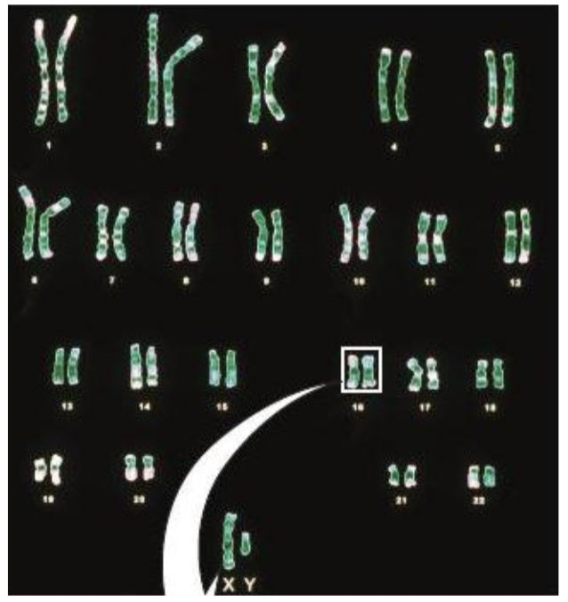
The box in this karyotype highlights which of the following?
Multiple choice question.
A pair of non-sister chromatids
A pair of non-homologous chromosomes
A pair of homologous chromosomes
A pair of sister chromatids
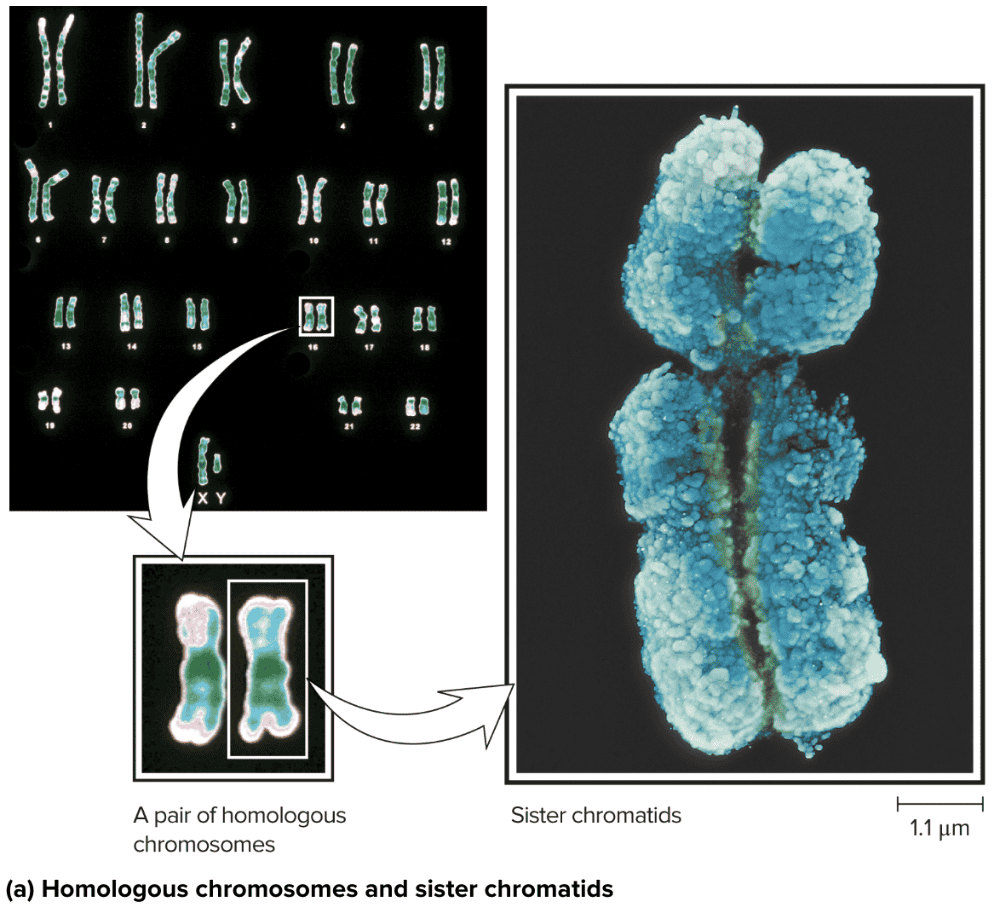
A pair of homologous chromosomes
When S phase is completed, a cell has _______ in the G1 phase.
Multiple choice question.
twice as many chromatids as chromosomes
as many chromatids as chromosomes
twice as many chromosomes as chromatids
four times as much DNA as
twice as many chromatids as chromosomes
What is a spindle pole?
Multiple choice question.
The site in an animal cell where the cleavage furrow forms
The site in a plant cell where the cell plate forms
The position in a plant cell where a centrosome is located
The position in an animal cell where a centrosome is located
The position in an animal cell where a centrosome is located
The term that can refer to either a dyad (pair of sister chromatids) or a monad (single chromatid) is a(n) ____.
chromosome
Each centrosome of an animal cell contains a pair of ____ at right angles to each other.
centrioles
The primary purpose of mitosis is to ______.
Multiple choice question.
ensure proper replication of the genetic material during the S phase of the cell cycle
distribute the replicated chromosomes equally into the two daughter cells
enhance the genetic diversity of a species via crossing-over between chromosomes
distribute the replicated chromosomes equally into the two daughter cells
True or false: Centrosomes and centrioles are found only in plant cells.
False
The microtubule-organizing centers (MTOCs) are structures found in eukaryotic cells from which microtubules grow to form the ______.
centromere
sister chromatid
kinetochore
spindle apparatus
spindle apparatus
Click and drag on elements in order
Rank the phases of mitosis in order, starting with the earliest at the top.
Telophase
Prometaphase
Prophase
Anaphase
Metaphase
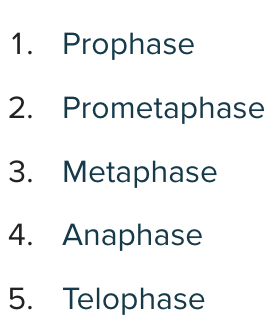
Answer in the picture
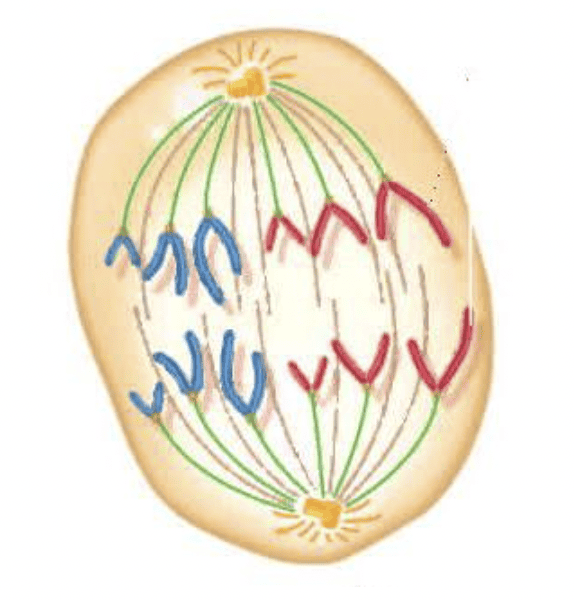
This diagram represents a cell that has an original diploid number (2n) of six chromosomes. The cell is shown in which phase of cell division?
Anaphase of mitosis
Anaphase II of meiosis
Metaphase II of meiosis
Metaphase of mitosis
Anaphase I of meiosis
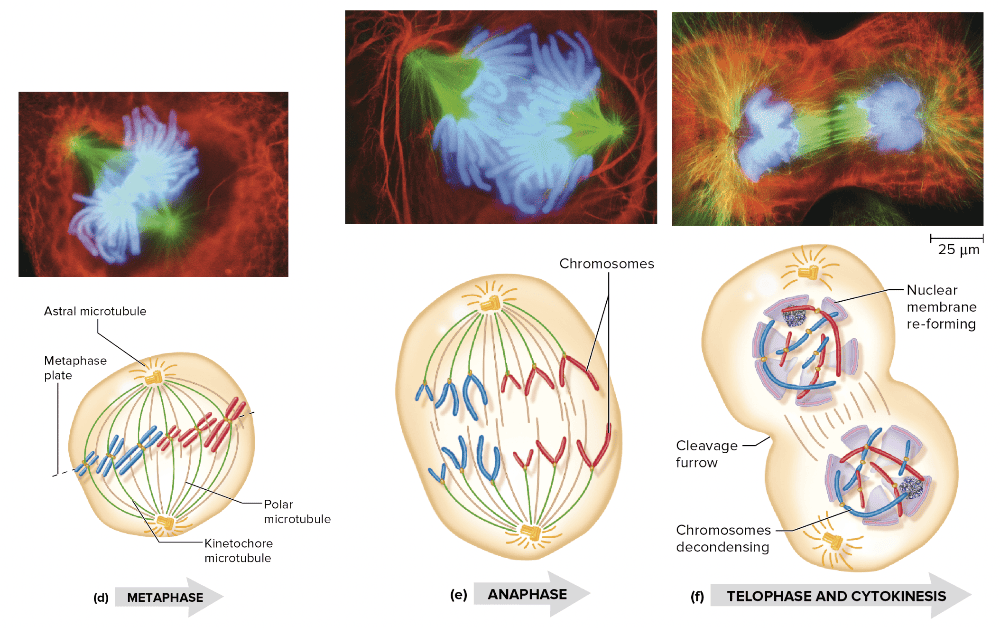
Anaphase of mitosis
In animals cells, each centrosome is located at a(n) ____ _____.
spindle pole
During prophase of mitosis, the nuclear membrane breaks down into small vesicles and the nucleolus becomes less visible. Furthermore, the two ____ move apart from each other and the mitotic ____ begins to form.
centrosomes; spindles
The two microtubule-organizing centers (MTOCs) that form the mitotic spindle of animal cells are called ______.
Multiple choice question.
centrioles
centromeres
centrosomes
centrophores
centrosomes
During ______, pairs of sister chromatids become attached to kinetochore microtubules which emanate from opposite poles of the cell.
Multiple choice question.
prometaphase
cytokinesis
metaphase
anaphase
prophase
prometaphase
Which of the following statements about centrosomes and centrioles is true?
Multiple choice question.
They are found only in plant cells
They are found only in animal cells
They are found in both animal and plant cells
They are found in all cells
They are found only in bacterial cells
They are found only in animal cells
Which of the following represents the sequence of phases during mitosis?
Multiple choice question.
Prophase — prometaphase — metaphase — anaphase — telophase
Prometaphase — prophase — metaphase — anaphase — telophase
Prophase — prometaphase — metaphase — telophase — anaphase
Prometaphase — prophase — metaphase — telophase — anaphase
Metaphase — prometaphase — prophase — anaphase — telophase
Prophase — prometaphase — metaphase — anaphase — telophase
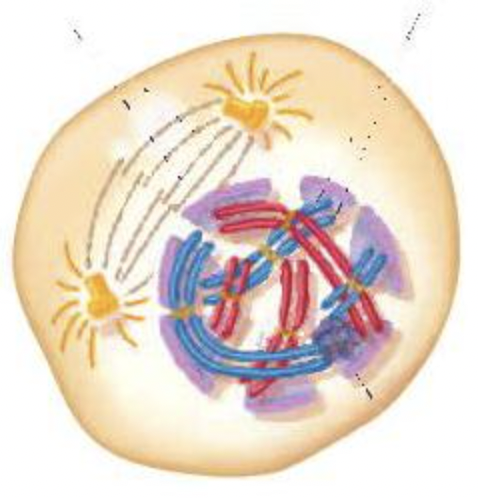
Consider a diploid cell that is 2n = 6. This diagram shows the cell in which phase of cell division?
Multiple choice question.
Prophase II of meiosis
Prophase of mitosis
Interphase of the cell cycle
Prophase I of meiosis
Metaphase of mitosis

Prophase of mitosis
During ____ of mitosis, chromosomes are aligned along the equatorial plate, or the center of the cell.
metaphase
Select all that apply
Select all of the following events that occur during prophase.
Multiple select question.
The chromatids become condensed.
The nuclear membrane begins to dissociate into small vesicles
The mitotic spindle begins to form.
The nucleolus becomes less visible.
The two centrosomes are replicated.
The chromatids become condensed.
The nuclear membrane begins to dissociate into small vesicles
The mitotic spindle begins to form.
The nucleolus becomes less visible.
All of the following events occur during prometaphase except ______.
Multiple choice question.
the chromosomes become visible with the light microscope
the spindle fibers “capture” chromosomes
the mitotic spindle is completely formed
the nuclear envelope completely breaks down
the chromosomes become visible with the light microscope
Which of the following events occurs during anaphase of mitosis?
Multiple choice question.
The mitotic spindle begins to break down
Pairs of sister chromatids become organized in a single row
Sister chromatids separate from each other and head to opposite poles
Chromosomes reach their respective poles and decondense
Sister chromatids separate from each other and head to opposite poles
Which of the following events occurs during metaphase of mitosis?
Multiple choice question.
The mitotic spindle is completely formed
Pairs of sister chromatids become organized in a single row
Sister chromatids separate from each other and head to opposite poles
The spindle fibers “capture” chromosomes
Pairs of sister chromatids become organized in a single row
During prophase of mitosis, the nuclear membrane breaks down into small vesicles and the nucleolus becomes less visible. Furthermore, the two ____ move apart from each other and the mitotic _____ begins to form.
centrosomes; spindles
During ______, pairs of sister chromatids become attached to kinetochore microtubules which emanate from opposite poles of the cell.
Multiple choice question.
prometaphase
metaphase
anaphase
prophase
cytokinesis
prometaphase
All of the following events occur during telophase except that the ______.
Multiple choice question.
chromosomes reach their respective poles and decondense
pairs of sister chromatids begin to separate from each other
nuclear membrane reforms to produce two separate nuclei
nucleolus or nucleoli become visible
pairs of sister chromatids begin to separate from each other
In plant cell cytokinesis, the two daughter cells are separated by the formation of a ______ made from the fusion of ______ vesicles carrying cell wall materials.
Multiple choice question.
cleavage furrow ; ER-derived
cell plate ; Golgi-derived
cell plate ; ER-derived
cleavage furrow ; Golgi-derived
cell plate ; Golgi-derived
During anaphase, the chromosomes move toward the pole to which they are attached. This movement is caused by the shortening of the ______.
Multiple choice question.
aster microtubules
sister chromatids
metaphase plate
kinetochore microtubules
kinetochore microtubules
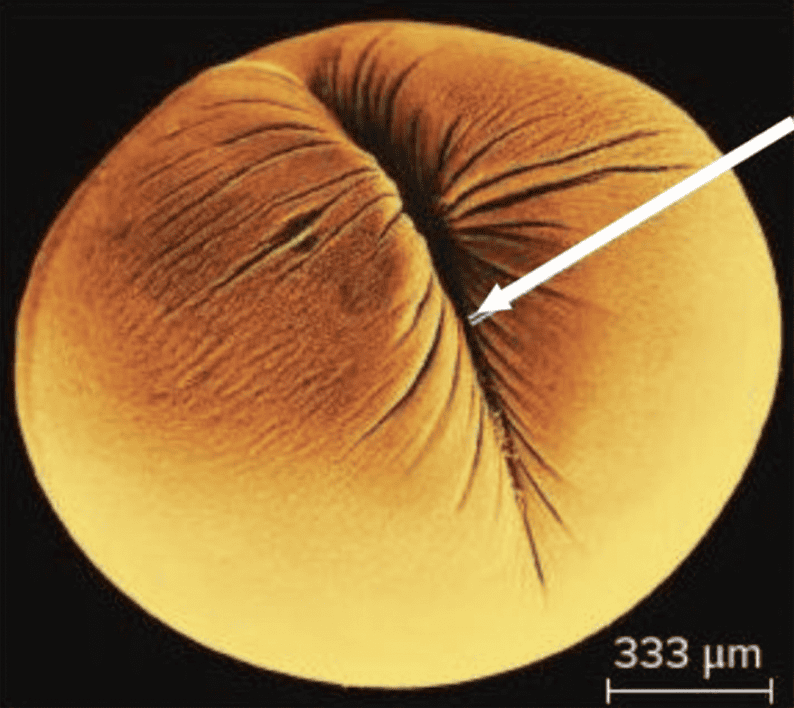
In this diagram, the arrow points to the ____ ____.
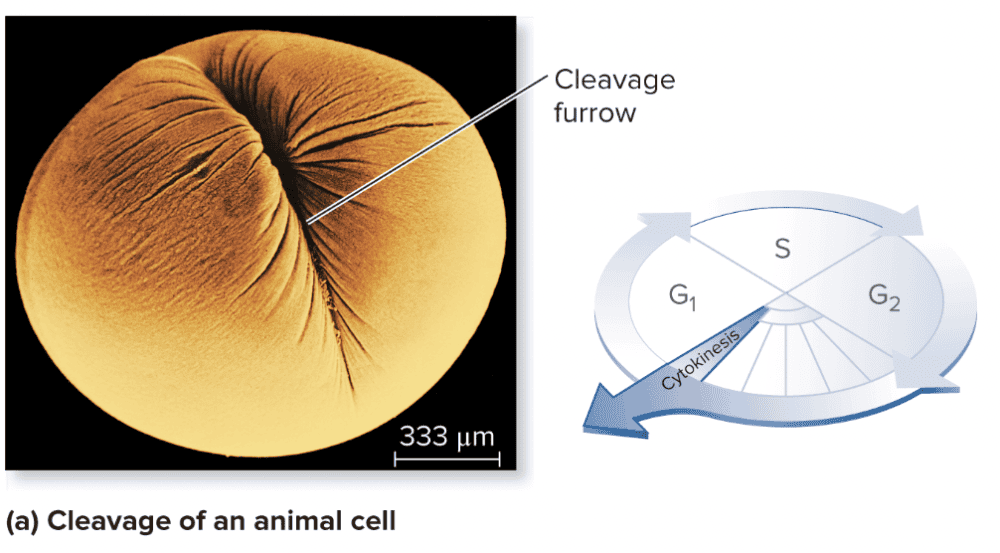
cleavage furrow
If the original diploid mother cell had eight chromosomes, a cell in telophase of mitosis would have ______ nuclei, each with ______ chromosomes.
Multiple choice question.
two; eight
four; eight
two; four
four; four
two; eight
Which of the following best describes the outcome of mitosis and cytokinesis in human somatic cells?
Multiple choice question.
1n → 2n
2n → 2n
2n → 1n
1n → 1n
2n → 2n
In animal cells, cytokinesis is accomplished by the formation of a ______ composed of ______ filaments.
Multiple choice question.
cleavage furrow; actin
cell plate; actin
cleavage furrow; tubulin
cell plate; tubulin
cleavage furrow; actin
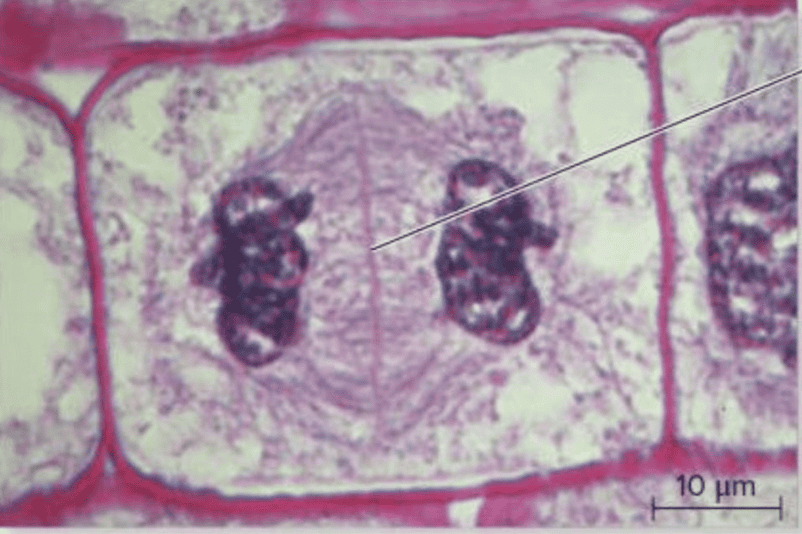
This micrograph shows a plant cell undergoing the process of ____ which occurs via the formation of a ____ ____ between the two daughter cells.
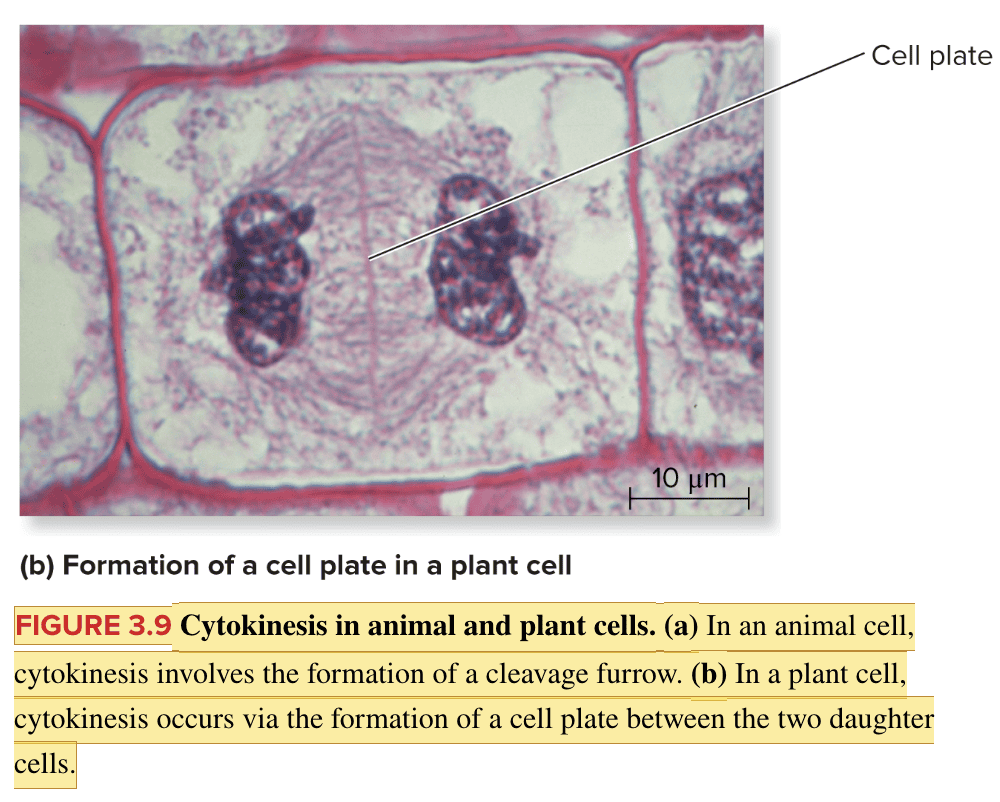
cytokinesis; cell plate
Eukaryotic cells that are diploid can divide by ______ to produce haploid sex cells.
meiosis
Mitosis and cytokinesis result in the formation of ______.
Multiple choice question.
four genetically identical daughter cells
two genetically identical daughter cells
two daughter cells that are genetically different from each other
four daughter cells that are genetically different from each other
two genetically identical daughter cells
What does a haploid cell contain?
Multiple choice question.
A single chromatid for each chromosome
A single pair of chromosomes
A single set of chromosomes
A single nuclear membrane
A single set of chromosomes
In plant cell cytokinesis, the two daughter cells are separated by the formation of a ______ made from the fusion of ______ vesicles carrying cell wall materials.
Multiple choice question.
cleavage furrow ; Golgi-derived
cleavage furrow ; ER-derived
cell plate ; Golgi-derived
cell plate ; ER-derived
cell plate ; Golgi-derived
Which of the following represents the correct order of stages of meiotic prophase I?
Multiple choice question.
Zygotene, diplotene, leptotene, diakinesis, pachytene
Zygotene, diplotene, diakinesis, pachytene, leptotene
Leptotene, pachytene, zygotene, diplotene, diakinesis
Leptotene, zygotene, pachytene, diplotene, diakinesis
Leptotene, zygotene, pachytene, diakinesis, diplotene
Leptotene, zygotene, pachytene, diplotene, diakinesis
In prophase I of meiosis, the replicated chromosomes begin to condense and become visible with a light microscope during which stage?
Multiple choice question.
Diplotene
Pachytene
Zygotene
Leptotene
Diakinesis
Leptotene
In prophase I of meiosis, the homologous chromosomes recognize each other and begin to align themselves during what stage?
Multiple choice question.
Leptotene
Zygotene
Diplotene
Diakinesis
Pachytene
Zygotene
In eukaryotes, ______ is the type of cell division that is responsible for the production of gametes.
Multiple choice question.
mitosis
meiosis
binary fission
meiosis
During prophase of meiosis I, homologous chromosomes recognize and begin to align with each other via a process called ____.
synapsis
A(n) ______ cell has a single set of chromosomes.
Multiple choice question.
triploid
tetraploid
diploid
haploid
A(n) ______ cell has a single set of chromosomes.
Multiple choice question.
triploid
tetraploid
diploid
haploid
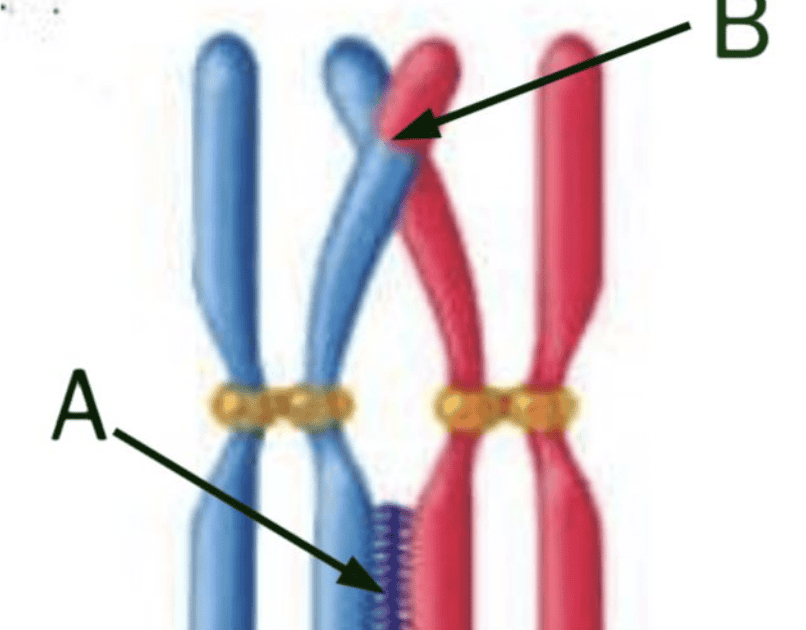
A pair of homologous chromosomes is shown here. Which of the following combinations show correct matches?
Multiple choice question.
A = synaptonemal complex ; B = chiasma
A = cleavage furrow ; B = chiasma
A = chiasma ; B = synaptonemal complex
A = synaptonemal complex ; B = cleavage furrow
A = cleavage furrow ; B = synaptonemal complex
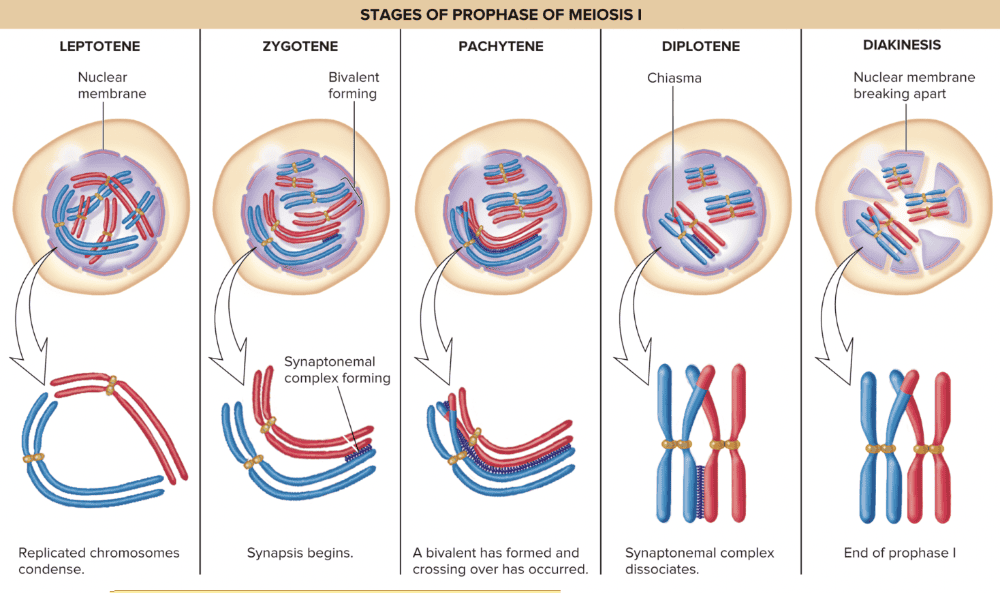
A = synaptonemal complex ; B = chiasma
Click and drag on elements in order
Arrange the stages of prophase I of meiosis in order, starting with the earliest phase at the top.
Leptotene
Diplotene
Pachytene
Diakinesis
Zygotene
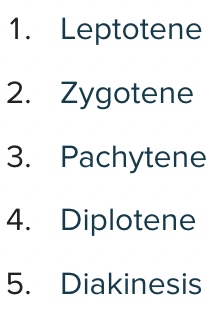
Answer in the picture
Synapsis is complete and crossing over occurs during which stage of prophase I of meiosis?
Multiple choice question.
Zygotene
Diakinesis
Leptotene
Pachytene
Diplotene
Pachytene
During the ____ stage of meiotic prophase I, the replicated chromosomes can be visualized by light microscopy.
leptotone
A bivalent, or tetrad, consists of ______.
Multiple choice question.
two pairs of sister chromatids
two non-homologous chromosomes
a sister chromatid and a non-sister chromatid
two chromatids of a replicated chromosome
two pairs of sister chromatids
Fill in the Blank Question
The process of synapsis begins in the ____ stage of prophase I of meiosis.
zygotene or zygonema
Synapsis is the process by which ______.
Multiple choice question.
tubulin filaments polymerize to form the spindle apparatus that separates the chromosomes during cell division.
chromosomes are replicated in the S phase of the cell cycle, prior to either mitosis or meiosis.
homologous chromosomes recognize each other and begin to align themselves in prophase I.
actin filaments polymerize to produce the cleavage furrow that divides the two animal daughter cells.
homologous chromosomes recognize each other and begin to align themselves in prophase I.
The interchange of corresponding chromatid segments of homologous chromosomes during prophase I of meiosis is called ______ ______.
Multiple choice question.
assortment
segregation
mutation
crossing over
crossing over
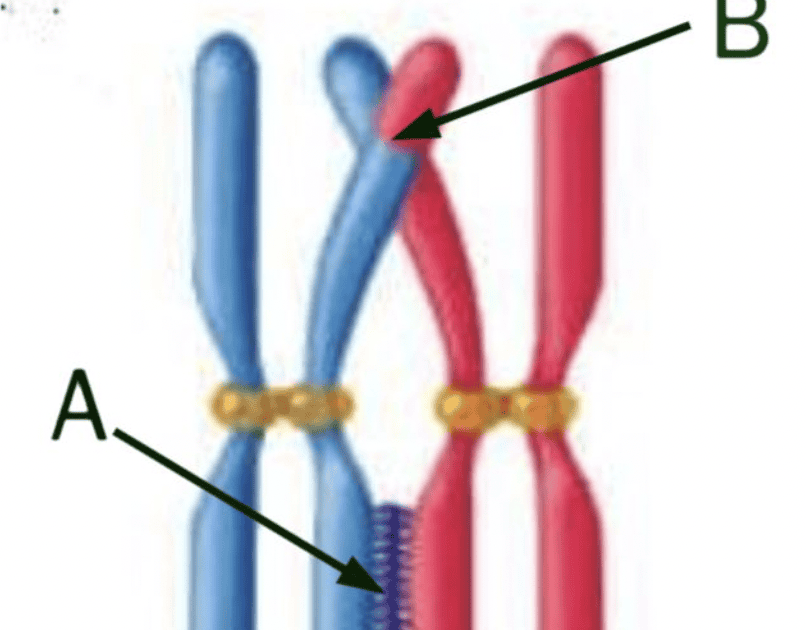
In this figure label A points to the ____ ____ while label B shows the ____, which is the connection that results from a crossing over.
synaptonemal complex; chiasma
During the ____ stage of meiotic prophase I, the homologous chromosomes have become completely aligned and crossing over occurs.
pachytene
Experiments in recent years have demonstrated the importance of ____ ____ for the normal segregation of chromosomes. For example, lack of this process has been associated with the presence of the extra chromosome 21 in a high percentage of individuals with Down syndrome.
crossing, cross, or recombination
over
A bivalent is also called a ____, because it is composed of four chromatids.
tetrad
The structure that is formed during crossing over is called a(n) ____, because it looks like the Greek letter chi, χ.
chiasma or chiasmata
In meiosis, crossing over refers to the physical exchange of pieces between ______ chromatids of ______ chromosomes.
Multiple choice question.
non-sister; non-homologous
non-sister; homologous
sister; homologous
sister; non-homologous
non-sister; homologous
The diplotene stage of meiotic prophase I is characterized by the ______.
Multiple choice question.
formation of the synaptonemal complex
dissociation of the synaptonemal complex
duplication of chromosomes to form chromatids
decondensation of chromosomes to form chromatin
dissociation of the synaptonemal complex
During Blank______ of meiosis, the spindle apparatus is complete and the chromatids are attached via kinetochore microtubules.
prometaphase I
prophase II
telophase I
anaphase II
prometaphase I
Defects in crossing-over appear to cause abnormalities in ______.
Multiple choice question.
chromosome segregation
chromosome replication
division of the cytoplasm
division of the nucleus
chromosome segregation
In ______ of meiosis, the bivalents (which are also termed tetrads) are aligned along the center of the cell.
Multiple choice question.
anaphase II
metaphase II
metaphase I
prophase I
prophase II
anaphase I
metaphase I
In humans, how many different, random chromosome alignments are possible during metaphase I of meiosis?
Multiple choice question.
222
223
246
245
223
Chiasmata refers to ______.
Multiple choice question.
the cleavage furrow that forms during cytokinesis
the connections that result from crossing-over
protein complexes that help in chromosome replication
a stage in prophase I of meiosis
the connections that result from crossing-over
During metaphase I of meiosis, one pair of chromatids in a bivalent (but not both) is attached to a ______. Therefore, each pair of sister chromatids is attached to only one pole.
Multiple choice question.
metaphase plate
kinetochore microtubule
nucleolus
telomere
centrosome
polar microtubule
kinetochore microtubule
The synaptonemal complex dissociates during the ____ stage of meiotic prophase I, and it completely disappears by the ____ stage.
diplotene; diakinesis
Which of the following statements about synapsis and crossing over is true?
Multiple choice question.
Both synapsis and crossing over occur in prophase I of meiosis
Synapsis occurs in prophase I and crossing over occurs in prometaphase I of meiosis
Both synapsis and crossing over occur in prometaphase I of meiosis
Synapsis occurs in prometaphase I and crossing over occurs in prophase I of meiosis
Both synapsis and crossing over occur in prophase I of meiosis
During which of the following phases are tetrads organized along a plate in the center of the cell?
Multiple choice question.
Metaphase of meiosis I
Prophase of meiosis I
Prophase of meiosis II
Metaphase of meiosis II
Metaphase of mitosis
Metaphase of meiosis I
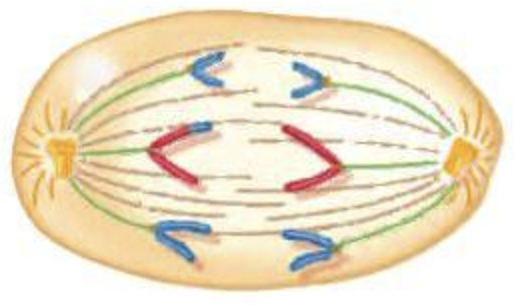
This diagram represents a cell that has an original diploid number (2n) of six chromosomes. The cell is shown in which phase of cell division?
Multiple choice question.
Anaphase of mitosis
Metaphase II of meiosis
Anaphase II of meiosis
Metaphase of mitosis
Anaphase I of meiosis
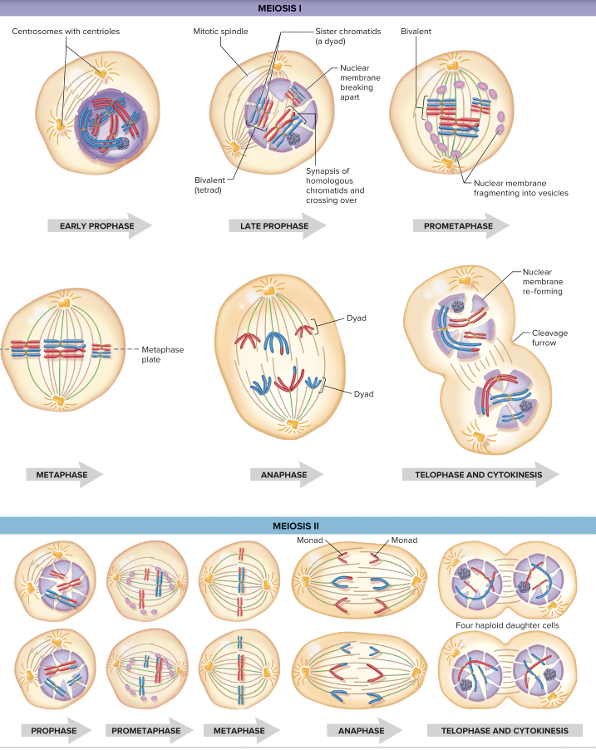
Anaphase II of meiosis
The fruit fly Drosophila melanogaster has four pairs of chromosomes. How many different, random chromosome alignments are possible during metaphase I of meiosis?
Multiple choice question.
4
16
8
32
16
The stage of meiosis I is characterized by the separation of the two pairs of sister chromatids within a bivalent from each other and their migration to opposite poles of the cell.
anaphase
Which of the following best describes how chromosomes are attached to microtubules during metaphase I of meiosis?
Multiple choice question.
A pair of sister chromatids is linked to both poles
Each member of a homologous pair of chromosomes is linked to both poles
One pair of sister chromatids is linked to one pole, and the homologous pair is linked to the other
One pair of sister chromatids is linked to one pole, and the homologous pair is linked to the other
Which of the following best describes the outcome of meiosis I in humans?
Multiple choice question.
1n → 2n
1n → 1n
2n → 2n
2n → 1n
2n → 1n
Select all that apply
Select all of these that are events of telophase I of meiosis.
Multiple select question.
Chromosomes condense in most species
Homologues have reached their respective poles
Homologues are aligned at the center of the cell
The nuclear membrane breaks down in most species
The nuclear membrane reforms in most species
Homologues have reached their respective poles
The nuclear membrane reforms in most species
During ____ of meiosis, the spindle apparatus is complete and the chromatids are attached via kinetochore microtubules.
Multiple choice question.
anaphase II
prophase II
telophase I
prometaphase I
prometaphase I
Consider an organism that has three pairs of chromosomes. At the start of meiosis II, each cell would have ______ chromosomes and ______ chromatids.
Multiple choice question.
six; six
three; three
three; six
six; three
three; six
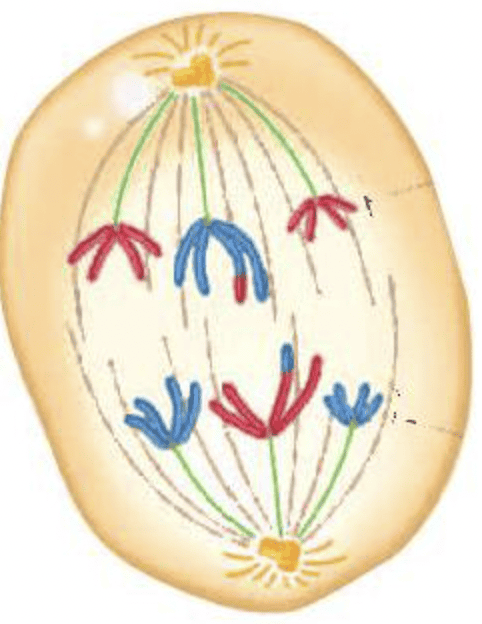
Consider a diploid cell with 2n = 6. This cell is shown in which phase of cell division?
Multiple choice question.
Anaphase II of meiosis
Metaphase II of meiosis
Metaphase of mitosis
Anaphase I of meiosis
Anaphase of mitosis

Anaphase I of meiosis
All of the following occur in mitosis except ______.
Multiple choice question.
chromosomes align on the metaphase plate of the cell
kinetochores begin attaching to spindle fibers
sister chromatids separate, and move to opposite poles
chromosomes condense, and nuclear envelope breaks down
pairing and synapsis of homologous chromosomes occurs
pairing and synapsis of homologous chromosomes occurs
Which of the following best describes the events of anaphase I of meiosis?
Multiple choice question.
The two pairs of sister chromatids separate and move to opposite poles.
The sister chromatids of each chromosome migrate to opposite poles.
The two pairs of sister chromatids migrate to the same pole.
The two pairs of sister chromatids separate and move to opposite poles.
Sexual reproduction involves the fusion of two ______ in the process of ______.
Multiple choice question.
gametes ; fertilization
gametes ; gametogenesis
somatic cells ; fertilization
somatic cells ; gametogenesis
gametes ; fertilization
Consider an organism that has four pairs of chromosomes. At the end of meiosis I, each cell would have ______ chromosomes and ______ chromatids.
Multiple choice question.
two; four
four; four
eight; eight
four; eight
four; eight
Gametes, or sex cells, are produced by a process called ____.
gametogenesis or meiosis
During ______ of meiosis, the pairs of sister chromatids (or dyads) reach the opposite poles of the cell, where in most cases, they decondense.
Multiple choice question.
prophase II
telophase I
anaphase I
metaphase II
metaphase I
telophase I
In humans, a diploid cell contains two sets of chromosomes, for a total of ____ chromosomes. In contrast, a gamete (sperm or egg cell) contains only a single set, consisting of ____ chromosomes.
46; 23
Which of the following best describes the starting material found in each cell entering meiosis II in humans?
Multiple choice question.
46 dyads
23 dyads
23 monads
23 bivalents
46 monads
23 dyads
Which of the following statements about mitosis and meiosis of humans is true?
Multiple choice question.
Mitosis produces two diploid daughter cells, while meiosis produces four haploid daughter cells.
Mitosis produces four haploid daughter cells, while meiosis produces two diploid daughter cells.
Mitosis produces two haploid daughter cells, while meiosis produces four diploid daughter cells.
Mitosis produces four diploid daughter cells, while meiosis produces two haploid daughter cells.
Mitosis produces two diploid daughter cells, while meiosis produces four haploid daughter cells.
Species that produce two morphologically different types of sex cells are said to be ______.
Multiple choice question.
heterozygotes
heteroploids
heterogeneous
heterogamous
heterogamous
What process involves the fusion of gametes in fertilization to produce a new organism?
Multiple choice question.
Asexual reproduction
Meiosis
Binary fission
Sexual reproduction
Mitosis
Sexual reproduction
Which of the following best describes the male and female gametes of animals?
Multiple choice question.
Female gametes tend to be smaller and less mobile than male gametes
Male gametes tend to be smaller and more mobile than female gametes
Female gametes tend to be smaller and more mobile than male gametes
Male gametes tend to be smaller and less mobile than female gametes
Male gametes tend to be smaller and more mobile than female gametes
True or false: Gametogenesis is the process by which gametes fuse to produce a new individual.
False
Male animals produce mature sperm by a process called
spermatogenesis or gametogenesis
A haploid cell is represented by 1n and a diploid cell by 2n. The n refers to ______.
Multiple choice question.
the number chromosomes in a cell
the number of genes in a cell
a set of chromosomes
the amount of DNA in a cell
a set of chromosomes
In the testes, a spermatogonial cell divides by ____ to produce two cells, one of which remains a spermatogonial cell, while the other cell becomes a ____ ____.
mitosis
primary
spermatocyte
Consider an organism that has three pairs of chromosomes. At the start of meiosis II, each cell would have ______ chromosomes and ______ chromatids.
Multiple choice question.
six; six
six; three
three; three
three; six
three; six
Click and drag on elements in order
Place these cells in the correct order in which they are involved in spermatogenesis, starting with the earliest at the top.
Spermatids
Sperm cells
Primary spermatocytes
Secondary spermatocytes
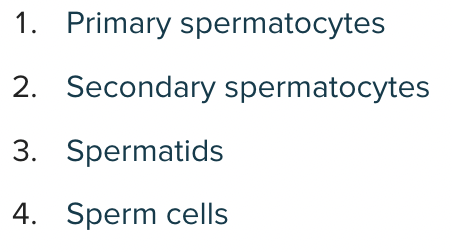
Answer in the picture
Most eukaryotic species are ____, which means they produce two gametes with different morphologies.
heterogamous
Fill in the Blank Question
The ____ is an organelle at the tip of a sperm which contains digestive enzymes used to penetrate the egg's outer layers.
acrosome
Fill in the Blank Question
In animals, male gametes are called ____ cells, while the female gamete is called an egg cell or ____.
sperm, spermatozoa, sperm cells, or sperms
ovum, oocyte, oocytes, ovule, or ova
The primary oocytes of a human female are formed ______, but are arrested in ______.
Multiple choice question.
before birth; prophase I of meiosis
before birth; prophase II of meiosis
at puberty; prophase I of meiosis
at puberty; prophase II of meiosis
before birth; prophase I of meiosis
Spermatogenesis takes place in the ______.
Multiple choice question.
testes
prostate gland
penis
seminal vesicles
testes
The earliest precursors to sperm cells are called ______ cells.
Multiple choice question.
spermatozoa
spermatogonial
spermatid
spermatocyte
spermatogonial
Oogenesis takes place in the ______.
Multiple choice question.
ovaries
vagina
Fallopian tubes
uterus
ovaries
How many haploid cells are produced from one primary spermatocyte in the process of spermatogenesis?
Multiple choice question.
Two
One
Eight
Four
Four
What is the role of the acrosome of a sperm?
Multiple choice question.
It encloses numerous mitochondria that provide the energy required for the sperm to function.
It contains the haploid nucleus that will fuse with the haploid egg's nucleus to form the diploid zygote.
It contains digestive enzymes that allow the sperm to penetrate the egg's outer protective layers.
It anchors the long flagellum that enables the mature sperm to travel and reach the egg to fertilize it.
It contains digestive enzymes that allow the sperm to penetrate the egg's outer protective layers.
In human females, the ____ ____ are produced before birth. However, they enter a dormant stage at prophase of meiosis I, and remain there until the female becomes sexually mature.
primary oocyte
Which two cells are produced by meiosis I in females?
Multiple choice question.
a larger primary oocyte and a smaller polar body
a larger primary oocyte and a smaller secondary oocyte
a larger secondary oocyte and a smaller primary oocyte
a smaller secondary oocyte and a larger polar body
a larger secondary oocyte and a smaller polar body
a larger secondary oocyte and a smaller polar body
During ovulation in female mammals, the ______ is released from the ovary into the oviduct. If a sperm then penetrates this cell, it is stimulated to complete meiosis II.
Multiple choice question.
primary oocyte
oogonium
secondary oocyte
zygote
secondary oocyte
Female animals produce egg cells by a process called ____.
oogenesis, gametogenesis, or meiosis
Which of the following statements about the life cycle of plants is true?
Certain cells in the sporophyte undergo meiosis to produce diploid cells, which divide by meiosis to produce a gametophyte.
Certain cells in the sporophyte undergo meiosis to produce haploid cells, which divide by mitosis to produce a gametophyte.
Certain cells in the gametophyte undergo meiosis to produce haploid cells, which divide by mitosis to produce a gametophyte.
Certain cells in the gametophyte undergo mitosis to produce diploid cells, which divide by meiosis to produce a gametophyte.
Certain cells in the sporophyte undergo meiosis to produce haploid cells, which divide by mitosis to produce a gametophyte.
In human oogenesis, the first meiotic division is asymmetrical and produces a secondary oocyte and a much smaller cell, known as a(n) ____ ____.
polar body
True or false: The gametophyte of flowering plants tends to be large, while that of mosses is typically small.
False
In human females, the egg cell that is fertilized is called the ______.
Multiple choice question.
secondary oocyte
follicle
oogonium
primary oocyte
secondary oocyte
Oogenesis takes place in the ______.
Multiple choice question.
Fallopian tubes
uterus
ovaries
vagina
ovaries
Which of the following statements about the life cycle of flowering plants is true?
Multiple choice question.
The ovaries of the gametophyte produce the male sporophyte, while the anthers of the gametophyte produce the female sporophyte.
The ovaries of the sporophyte produce the male gametophyte, while the anthers of the sporophyte produce the female gametophyte.
The anthers of the gametophyte produce the male sporophyte, while the ovaries of the gametophyte produce the female sporophyte.
The anthers of the sporophyte produce the male gametophyte, while the ovaries of the sporophyte produce the female gametophyte.
The anthers of the sporophyte produce the male gametophyte, while the ovaries of the sporophyte produce the female gametophyte.
In flowering plants, the male gametophyte with a thick cell wall is called the ____ ____.
pollen grains
The life cycles of plant species alternate between haploid and diploid generations. The haploid generation is called the ____, whereas the diploid generation is called the ____.
gametophyte
sporophyte
In flowering plants, the female gametophytes are formed within structures called ____, which are found in the ovaries.
ovules
Which of the following statements about the gametophyte of plants is true?
Multiple choice question.
The gametophyte of simpler plants, such as mosses, tends to be large, while that of flowering plants is typically small.
The gametophyte of simpler plants, such as mosses, tends to be small, while that of flowering plants is typically large.
The gametophyte of all plants is typically small, regardless of the plant's complexity.
The gametophyte of all plants is typically large, regardless of the plant's complexity.
The gametophyte of simpler plants, such as mosses, tends to be large, while that of flowering plants is typically small.
During ovulation in female mammals, the ______ is released from the ovary into the oviduct. If a sperm then penetrates this cell, it is stimulated to complete meiosis II.
Multiple choice question.
oogonium
secondary oocyte
primary oocyte
zygote
secondary oocyte
Meiosis in flowering plants occurs in two different parts of the sporophyte: the ____, which produce the male gametophyte, and the ____, which produce the female gametophyte.
anther; ovaries
The pollen grain is the ______ in flowering plants.
Multiple choice question.
female gametophyte
male sporophyte
male gametophyte
female sporophyte
male gametophyte
Which of the following are produced within ovules found in the plant ovaries?
Multiple choice question.
Female sporophytes
Female gametophytes
Male gametophytes
Male sporophytes
Female gametophytes
Which of the following statements about the life cycle of flowering plants is true?
Multiple choice question.
The ovaries of the sporophyte produce the male gametophyte, while the anthers of the sporophyte produce the female gametophyte.
The anthers of the gametophyte produce the male sporophyte, while the ovaries of the gametophyte produce the female sporophyte.
The anthers of the sporophyte produce the male gametophyte, while the ovaries of the sporophyte produce the female gametophyte.
The ovaries of the gametophyte produce the male sporophyte, while the anthers of the gametophyte produce the female sporophyte.
The anthers of the sporophyte produce the male gametophyte, while the ovaries of the sporophyte produce the female gametophyte.
The embryo sac is the _______ in flowering plants.
Multiple choice question.
female gametophyte
male gametophyte
male sporophyte
female sporophyte
female gametophyte
In flowering plants, the female gametophytes are formed within structures called ____, which are found in the ovaries.
ovule
The endosperm is a
Multiple choice question.
diploid cell in plants that undergoes meiosis to produce gametes.
tetraploid structure in plants that acts as a food storing tissue.
triploid structure in plants that acts as a food storing tissue.
tetraploid cell in plants that undergoes meiosis to produce gametes.
triploid structure in plants that acts as a food storing tissue.
Fertilization in plants involves all of the following steps except ______.
Multiple choice question.
the sperm cells migrate through the endosperm tissue and eventually reach the site of fertilization
a pollen tube grows through the style and eventually makes contact with an ovule
a pollen grain lands on a stigma and stimulates the tube cell to sprout a pollen tube
the generative cell undergoes mitosis to produce two haploid sperm cells
the sperm cells migrate through the endosperm tissue and eventually reach the site of fertilization
During ovulation in female mammals, the ______ is released from the ovary into the oviduct. If a sperm then penetrates this cell, it is stimulated to complete meiosis II.
Multiple choice question.
secondary oocyte
oogonium
zygote
primary oocyte
secondary oocyte
Which of the following statements about gametes is true?
Multiple choice question.
Both animals and plants produce gametes by meiosis.
Animals produce gametes by meiosis, while plants produce gametes by mitosis.
Both animals and plants produce gametes by mitosis.
Animals produce gametes by mitosis, while plants produce gametes by meiosis.
Animals produce gametes by meiosis, while plants produce gametes by mitosis.
In flowering plants, the female gametophyte is a seven-celled structure called the ____ ____.
embryo sac
All of the following are fundamental principles of the chromosome theory of inheritance except ______.
Multiple choice question.
chromosome replication occurs during the S phase of the cell cycle
during the formation of haploid cells, different types of chromosomes segregate independently of each other
chromosomes passed along, generation after generation, from parent to offspring
chromosomes contain the genetic material that is transmitted from parent to offspring and from cell to cell
each parent contributes one set of chromosomes to its offspring
chromosome replication occurs during the S phase of the cell cycle
Fertilization in plants involves the formation of a triploid (3n) cell. This cell undergoes repeated mitotic divisions to produce ____, which serves as a nutrition source.
endosperm
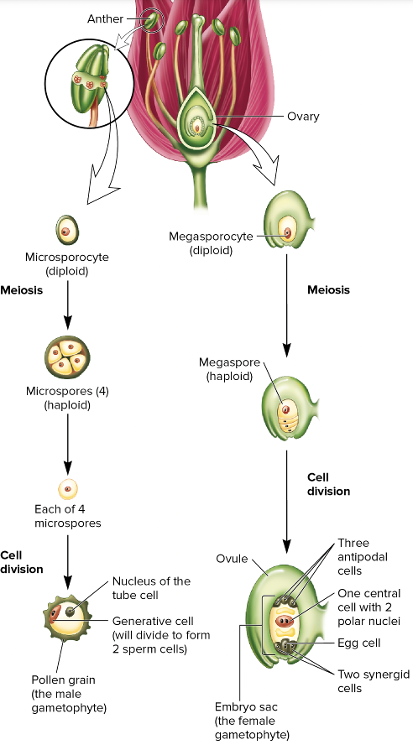
The following are steps of plant fertilization. Arrange them in the proper sequence, starting with the earliest at the top.

Answer in the picture
Mendel’s law of ____ can be explained by the homologous pairing and separation of chromosomes during meiosis.
segregation
In plants, the gametophyte is a haploid multicellular organism formed as a result of repeated ____ cellular divisions of a haploid spore. Inside this gametophyte, some cells become specialized as ____.
mitotic; gametes
A fundamental principle of the chromosome theory of inheritance involves the chromosome composition of cells. Most eukaryotic cells are diploid, containing chromosomes that are found in ____ pairs. During the process of ____, the two members of each pair segregate into different daughter nuclei.
homologous or homolog
meiosis
An endosperm is ____?
a triploid (3n) cell that acts as food-storing tissue
What aspect of chromosome behavior is consistent with Mendel's law of independent assortment?
Multiple choice question.
Independent alignment of different homologous pairs along the metaphase I plate
Production of genetically identical daughter cells during mitosis
Replication of chromosomes during the S phase prior to meiosis
Movement of sister chromatids to opposite poles during anaphase II of meiosis
Independent alignment of different homologous pairs along the metaphase I plate
The behavior of chromosomes during meiosis explains Mendel's law of segregation. Specifically, a gamete contains only one copy of each type of chromosome because of which of the following?
Multiple choice question.
The sister chromatids segregate during meiosis I and then again during meiosis II
The homologs segregate during meiosis I and then again during meiosis II
The homologs segregate during meiosis I and the sister chromatids separate during meiosis II
The sister chromatids segregate during meiosis I and the homologs separate during meiosis II
The homologs segregate during meiosis I and the sister chromatids separate during meiosis II
True or false: Sex chromosomes are chromosomes that determine sex in all species.
False
All of the following are fundamental principles of the chromosome theory of inheritance except ______.
Multiple choice question.
during the formation of haploid cells, different types of chromosomes segregate independently of each other
each parent contributes one set of chromosomes to its offspring
chromosome replication occurs during the S phase of the cell cycle
chromosomes contain the genetic material that is transmitted from parent to offspring and from cell to cell
chromosomes passed along, generation after generation, from parent to offspring
chromosome replication occurs during the S phase of the cell cycle
The random arrangement of homologs along the metaphase plate in meiosis I is consistent with Mendel’s law of ____ ____.
Independent assortment
The X-Y system of sex determination is used by ______.
Multiple choice question.
insects
reptiles
birds
mammals
plants
mammals
True or false: A heterogametic sex produces two types of sex cells, while a homogametic sex produces sex cells of only one type.
True
Mendel’s law of ____ can be explained by the homologous pairing and separation of chromosomes during meiosis.
segregation
A human cell contains two main types of chromosomes: sex chromosomes and ____.
autosomes
Chromosomes that determine whether an individual is a male or female are called ____ ____.
sex chromosomes
Which of the following genes plays a key role in male development?
Multiple choice question.
Yac
Sry
Xist
Xec
Sry
A fundamental principle of the chromosome theory of inheritance involves the chromosome composition of cells. Most eukaryotic cells are diploid, containing chromosomes that are found in ____ pairs. During the process of ____, the two members of each pair segregate into different daughter nuclei.
homologous; meiosis
Which of the following statements about the X-0 system of sex determination is true?
Multiple choice question.
The male has one sex chromosome designated X, while the female has another sex chromosome designated 0.
The male has one sex chromosome designated 0, while the female has another sex chromosome designated X.
The male has one sex chromosome (the X) and is designated X0, whereas the female has two X chromosomes.
The female has one sex chromosome (the X) and is designated X0, whereas the male has two X chromosomes.
The male has one sex chromosome (the X) and is designated X0, whereas the female has two X chromosomes.
Which of the following statements about the X-Y system of sex determination is true?
Multiple choice question.
The male is XY and the female is YY.
The male is XY and the female is XX.
The female is XY and the male is XX.
The female is XX and the male is YY.
The male is XY and the female is XX.
In many insect species, sex is determined by the ratio between ____ chromosomes and the number of ____ sets.
sex; autosome
In humans, the male is known as the ____ sex, because one type of sperm carries only the X chromosome, and another type carries the Y chromosome. The female, on the other hand, is the ____ sex because all eggs carry a single X chromosome.
heterogametic; homogametic
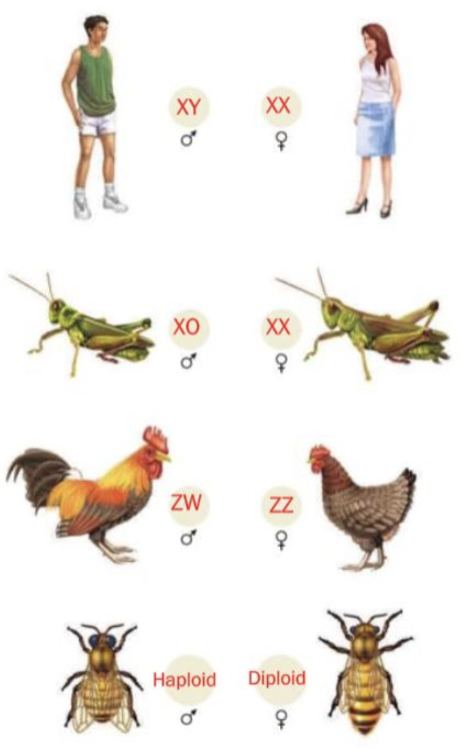
This figure shows the sex determination mechanisms of various animals. In which animal, are the male and female descriptions switched?
Multiple choice question.
Mammals
Insects
Birds
Bees
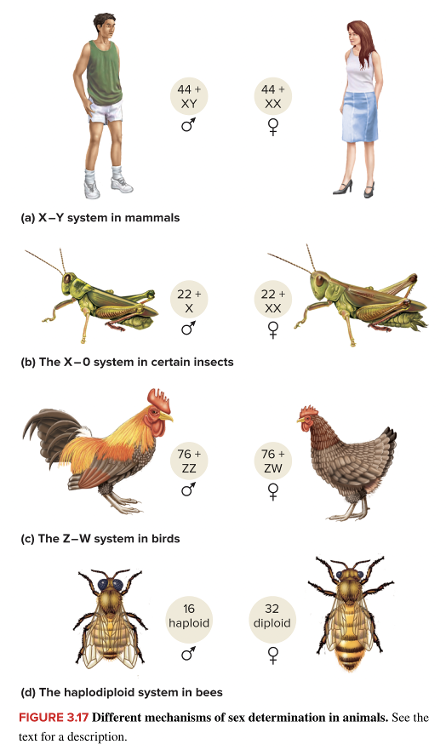
Birds
Chromosomes that are not sex chromosomes are called ______.
Multiple choice question.
autosomes
protosomes
euchromatin
heterochromatin
autosomes
Consider a Drosophila fruit fly that has two sets of autosomes and a sex chromosome composition XXY. This fly would be a(n) ______.
Multiple choice question.
female
male
female
The gene on the Y chromosome plays a key role in causing the development of male characteristics.
Sry
Which of the following statements about the Z-W system of sex determination is true?
Multiple choice question.
The male is ZZ and is the homogametic sex, while the female is ZW and is the heterogametic sex.
The female is ZZ and is the homogametic sex, while the male is ZW and is the heterogametic sex.
The male is WW and is the homogametic sex, while the female is ZW and is the heterogametic sex.
The female is WW and is the homogametic sex, while the male is ZW and is the heterogametic sex.
The male is ZZ and is the homogametic sex, while the female is ZW and is the heterogametic sex.
In the X-0 system of sex determination, the male's chromosomes are listed as ____, whereas the female's chromosomes are listed as ____.
XO
XX
In the haplodiploid system of sex determination, the male is ____, whereas the female is ____.
haploid or unfertilized
diploid or fertilized
In Drosophila melanogaster, sex is determined by the ______.
Multiple choice question.
Z-W system of sex chromosomes
X-Y system of sex chromosomes
ratio between X chromosomes and the number of autosomes
ratio between X chromosomes and the number of autosomal sets
ratio between X chromosomes and the number of autosomal sets
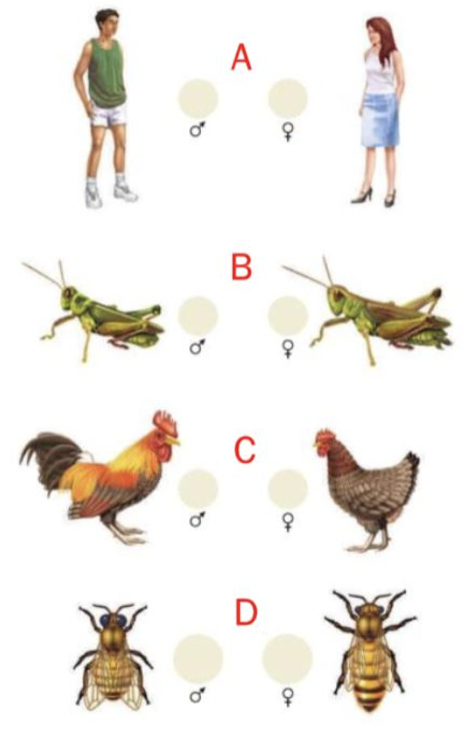
Match the animal to its appropriate mechanism of sex determination.
Instructions
A
B
C
D
Haplodiploid system
X-0 system
Z-W system
X-Y system

- A X-Y system
- B X-0 system
- C Z-W system
- D Haplodiploid system
Select all that apply
Sex-determination systems that are controlled by the environmental temperature are seen in what group of animals?
Multiple select question.
Fish
Birds
Reptiles
Insects
Mammals
Fish
Reptiles
An abnormal fruit fly has two sets of autosomes, a single X chromosome, and no Y chromosomes. This fly would be a(n) ______.
Multiple choice question.
male
female
intersex
male
In the Z-W system of sex determination, the male is designated ______, whereas the female is designated ______.
ZZ; ZW
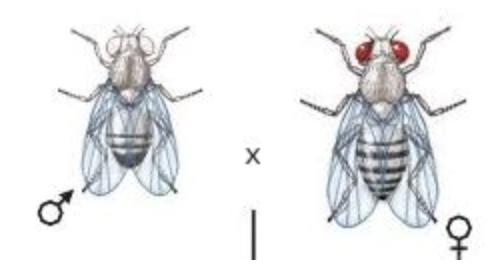
Consider this testcross between a white-eyed male fruit fly and a heterozygous red-eyed female. The offspring are expected in what proportion?
Multiple choice question.
2 white-eyed males : 1 red-eyed female : 1 white-eyed female
1 red-eyed male : 1 white-eyed male : 1 red-eyed female : 1 white-eyed female
2 red-eyed males : 1 red-eyed female : 1 white-eyed female
1 red-eyed male : 1 white-eyed male : 2 red-eyed females
1 red-eyed male : 1 white-eyed male : 2 white-eyed females
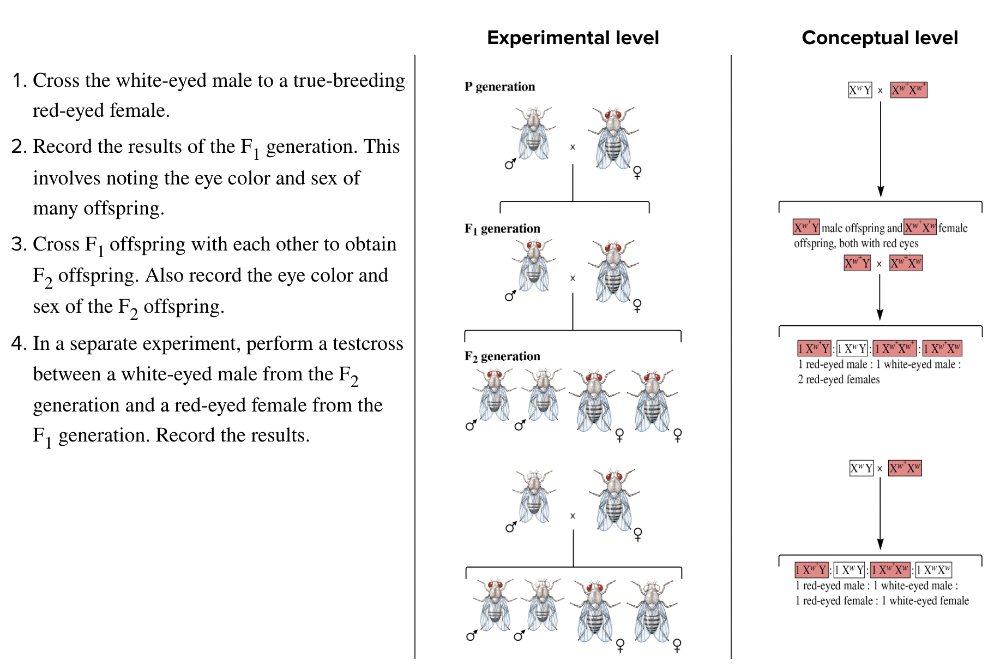
1 red-eyed male : 1 white-eyed male : 1 red-eyed female : 1 white-eyed female
Which of the following statements about the haplodiploid system of sex determination is true?
Multiple choice question.
Males and female workers are haploid, while female queens are diploid.
Males are haploid, while females are diploid.
Females are haploid, while males are diploid.
Males and female queens are diploid, while female workers are haploid.
Males are haploid, while females are diploid.
Multiple Choice Question
When Thomas Hunt Morgan crossed the red-eyed F1 generation fruit flies with each other, the F2 generation included both red-eyed and white-eyed individuals. Interestingly, all the white-eyed flies were male. What did these results indicate?
Multiple choice question.
The eye color gene was on the Y chromosome
Eye color in fruit flies is influenced by female-specific non-chromosome factors
The eye color gene was on the X chromosome
The eye color gene was on an autosome
Eye color in fruit flies is influenced by male-specific non-chromosome factors
The eye color gene was on the X chromosome
In the American alligator, sex is determined by the ______.
Multiple choice question.
haplodiploid system
environmental temperature
X-0 chromosomal system
X-Y chromosomal system
Z-W chromosomal system
environmental temperature
Genes that are physically located on the X chromosome are called X- ____ genes.
linked

What ratio of offspring is expected from this cross of two Drosophila flies (Xw- Y x Xw+ Xw+)?
Multiple choice question.
1 red-eyed male : 1 red-eyed female
1 red-eyed male : 1 white-eyed female
1 white-eyed male : 1 white-eyed female
1 white-eyed male : 1 red-eyed female

1 red-eyed male : 1 red-eyed female
Which of the following is an example of a testcross in Drosophila melanogaster?
Multiple choice question.
A cross between a red-eyed male and a white-eyed female
A cross between a white-eyed male and a white-eyed female
A cross between a white-eyed male and a red-eyed female
A cross between a white-eyed male and a red-eyed female
In his experiment, Morgan crossed a red-eyed female with a white-eyed male. Which of the following results allowed Morgan to conclude that the locus affecting eye color was on the X chromosome?
Multiple choice question.
In the F1 generation, all male and female flies had red eyes.
In the F2 generation, all males had red eyes, while half of the females had red eyes and the other half had white eyes.
In the F2 generation, all females had red eyes, while half of the males had red eyes and the other half had white eyes.
In the F2 generation, half of males and females had red eyes, while the other half had white eyes.
In the F1 generation, all male and female flies had white eyes.
In the F2 generation, all females had red eyes, while half of the males had red eyes and the other half had white eyes.
_______ genes are those that are physically located on the X chromosome.
Multiple choice question.
X-associated
X-linked
X-limited
X-influenced
X-linked
In a Drosophila melanogaster ____, a fly with a dominant phenotype and unknown genotype is mated to one that has a recessive phenotype.
testcross
When Thomas Hunt Morgan crossed the red-eyed F1 generation fruit flies with each other, the F2 generation included both red-eyed and white-eyed individuals. Interestingly, all the white-eyed flies were male. What did these results indicate?
Multiple choice question.
Eye color in fruit flies is influenced by female-specific non-chromosome factors
The eye color gene was on the X chromosome
Eye color in fruit flies is influenced by male-specific non-chromosome factors
The eye color gene was on an autosome
The eye color gene was on the Y chromosome
The eye color gene was on the X chromosome
